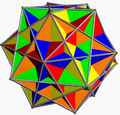Top Qs
Timeline
Chat
Perspective
Compound of five cubes
Polyhedral compound From Wikipedia, the free encyclopedia
Remove ads
The compound of five cubes is one of the five regular polyhedral compounds. It was first described by Edmund Hess in 1876.
| Compound of five cubes | |
|---|---|
 (Animation, 3D model) | |
| Type | Regular compound |
| Coxeter symbol | 2{5,3}[5{4,3}][1][2] |
| Stellation core | rhombic triacontahedron |
| Convex hull | Dodecahedron |
| Index | UC9 |
| Polyhedra | 5 cubes |
| Faces | 30 squares (visible as 360 triangles) |
| Edges | 60 |
| Vertices | 20 |
| Dual | Compound of five octahedra |
| Symmetry group | icosahedral (Ih) |
| Subgroup restricting to one constituent | pyritohedral (Th) |


Its vertices are those of a regular dodecahedron. Its edges form pentagrams, which are the stellations of the pentagonal faces of the dodecahedron.
It is one of the stellations of the rhombic triacontahedron. Its dual is the compound of five octahedra. It has icosahedral symmetry (Ih).
The compound of five cubes can also be known as a rhombihedron.
Remove ads
Geometry
The compound is a faceting of the dodecahedron. Each cube represents a selection of 8 of the 20 vertices of the dodecahedron.
 |
 |
 |
 |
| Views from 2-fold, 5-fold and 3-fold symmetry axis | |||
If the shape is considered as a union of five cubes yielding a simple nonconvex solid without self-intersecting surfaces, then it has 360 faces (all triangles), 182 vertices (60 with degree 3, 30 with degree 4, 12 with degree 5, 60 with degree 8, and 20 with degree 12), and 540 edges, yielding an Euler characteristic of 182 − 540 + 360 = 2.
Remove ads
Edge arrangement
Its convex hull is a regular dodecahedron.[3] It additionally shares its edge arrangement with the small ditrigonal icosidodecahedron, the great ditrigonal icosidodecahedron, and the ditrigonal dodecadodecahedron. With these, it can form polyhedral compounds that can also be considered as degenerate uniform star polyhedra; the small complex rhombicosidodecahedron, great complex rhombicosidodecahedron and complex rhombidodecadodecahedron.
 Small ditrigonal icosidodecahedron |
 Great ditrigonal icosidodecahedron |
 Ditrigonal dodecadodecahedron |
 Dodecahedron (convex hull) |
 Compound of five cubes |
 As a spherical tiling |
The compound of ten tetrahedra can be formed by taking each of these five cubes and replacing them with the two tetrahedra of the stella octangula (which share the same vertex arrangement of a cube).
Remove ads
As a stellation
This compound can be formed as a stellation of the rhombic triacontahedron.
The 30 rhombic faces exist in the planes of the 5 cubes.
 The yellow area corresponds to one cube face. |
 In the top right the same figure as on the left. In the bottom right a stellation diagram of the compound of five octahedra. |
See also
 |
Footnotes
References
External links
Wikiwand - on
Seamless Wikipedia browsing. On steroids.
Remove ads
